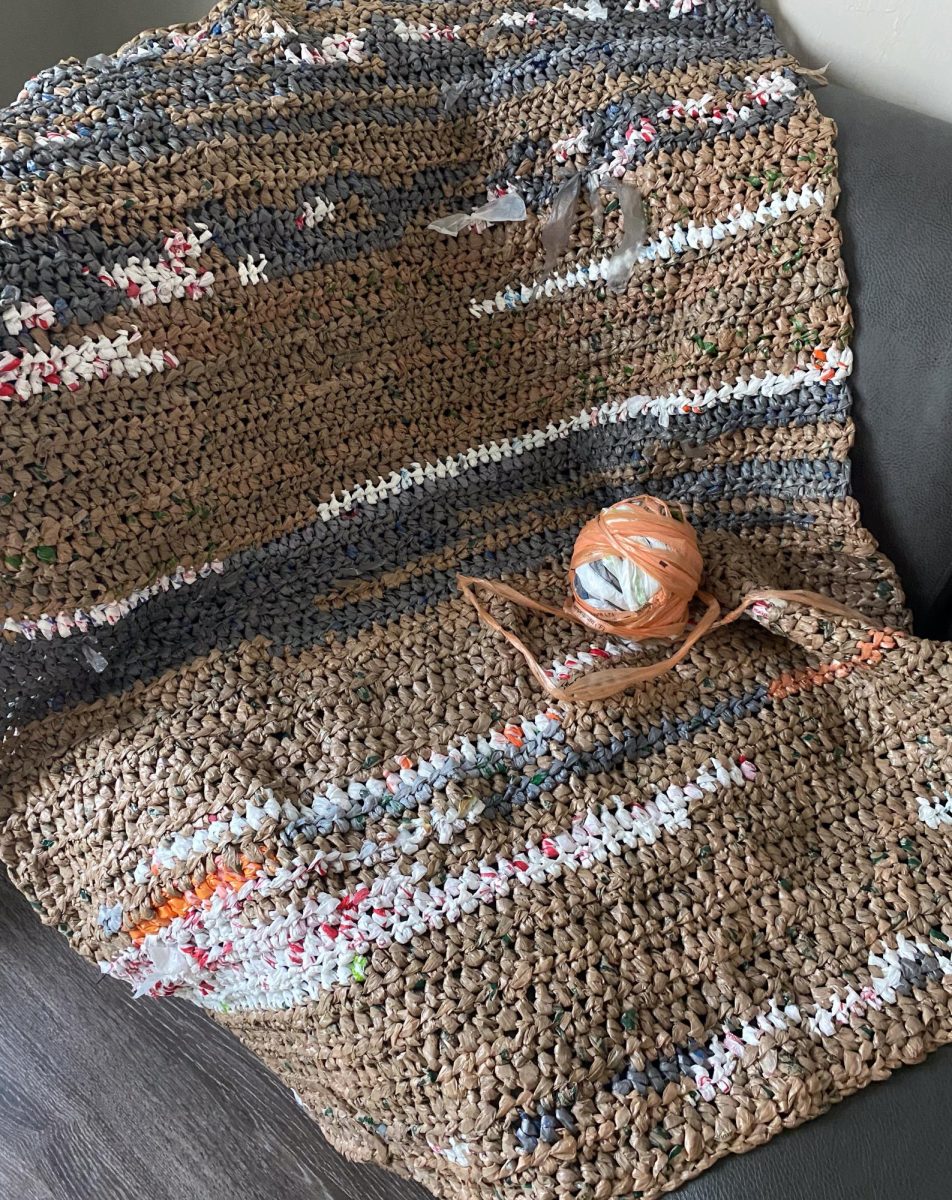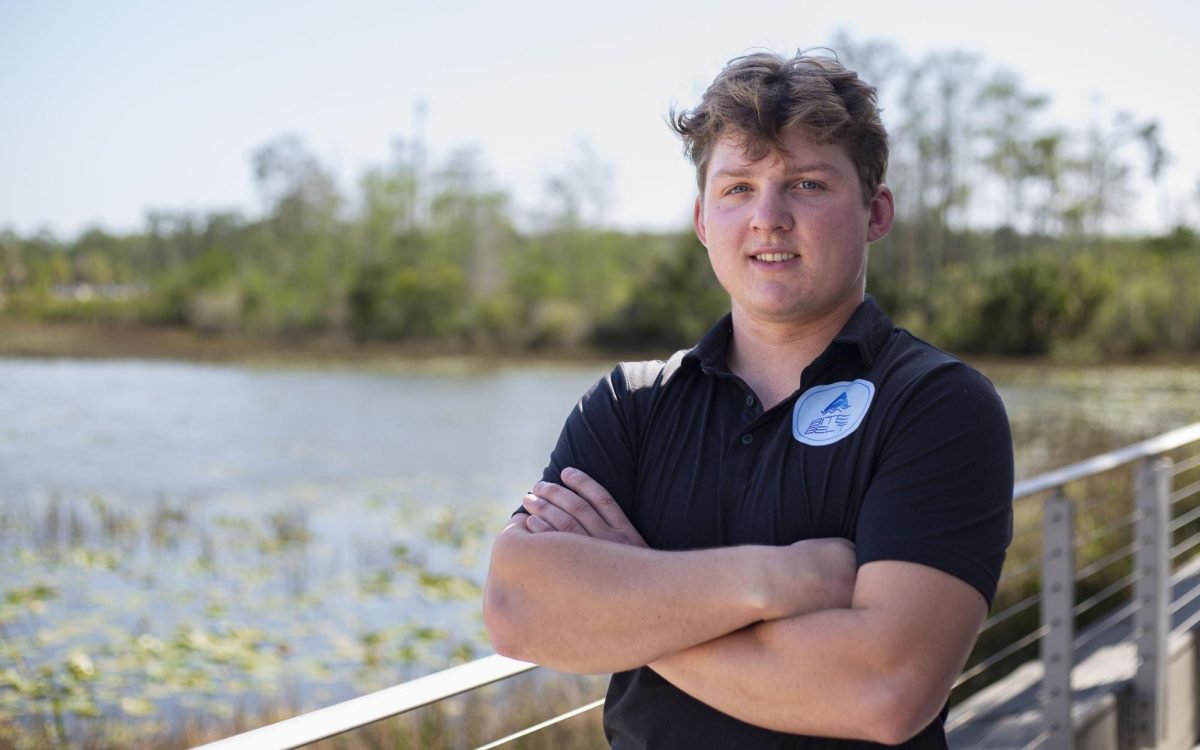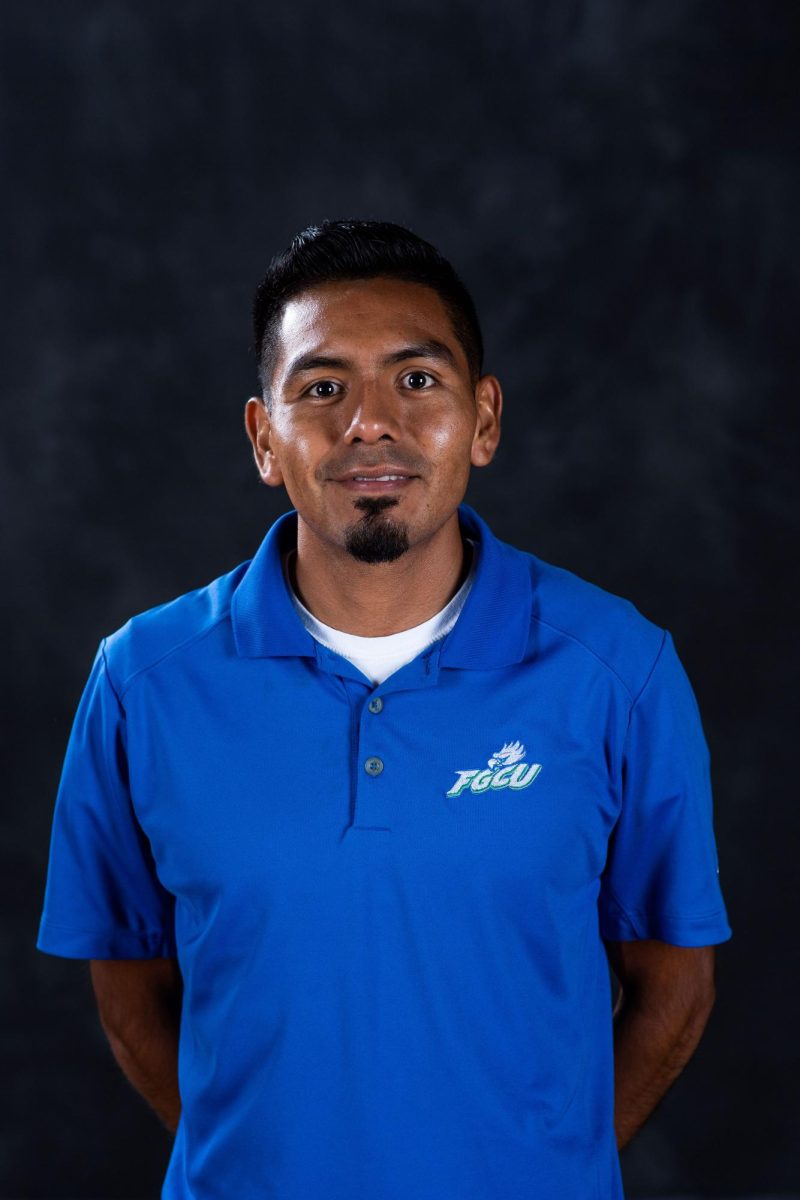Story by: Klaudia Balogh
On Tuesday, Planet Fitness celebrated its grand opening with a ribbon cutting ceremony in San Carlos Park.
The newest location of the franchise opened Dec. 17 and has shown a growing interest with locals. There are three other locations in Fort Myers
“So far the turnout has been phenomenal,” said Kris Glidden, the franchisee and owner of Planet Fitness in San Carlos. “We love the response as far as memberships and the business side of things, but also just the people too we’ve been meeting here. It’s been really nice.”
To make the ribbon cutting a unique event, a familiar face joined the ceremony. Planet Fitness invited Danni Allen, the season 14 winner of NBC’s “The Biggest Loser.”
Planet Fitness, as the main sponsor of the show “The Biggest Loser,” wants to reach people who wouldn’t typically walk into a gym.
“I’m really excited to be here,” Allen said. “The more I get to move around and travel and show people that it’s not as hard as you think; just walk through that front door and there are people here to guide you.”
Planet Fitness is known for its judgment-free zone and non-intimidating environment, welcoming new and regular gym-goers with a variety of cardio and weight equipment along with different specialty rooms — abs and stretching and PF 360 — so members can choose from a number of ways to train.
Besides workout equipment, tanning beds and massage chairs are also available in the facility depending on the member’s membership type.
For more information on memberships, visit planetfitness.com or visit the gym at 18011 South Tamiami Trail.
Planet Fitness celebrates ribbon cutting with “The Biggest Loser” winner
January 15, 2016
Story continues below advertisement
View Comments (13)
More to Discover
CONTACT US
10501 FGCU Blvd. South
Fort Myers, FL 33965
Phone: 239.590.7945
EXECUTIVE EDITOR
Tori Foltz
[email protected]
STUDENT MEDIA ADVISER
Justin Paprocki
[email protected]
10501 FGCU Blvd. South
Fort Myers, FL 33965
Phone: 239.590.7945
EXECUTIVE EDITOR
Tori Foltz
[email protected]
STUDENT MEDIA ADVISER
Justin Paprocki
[email protected]











































Tanner • Jan 17, 2016 at 6:40 pm
Wow, you really back up your saviour the FDA. You are the perfect sheeple, pretty good at copy and paste too. Do you have any idea how many people died last year from prescription pill approved by the FDA? You, Donna and all the rest keep drinking your cool-aid.
Linda • Jan 17, 2016 at 4:15 pm
Big pharma (and big medicine) – warts and all – has saved my life on more than one occasion. It helped deliver my children safely, and continues to help members of my family to this day. I take vitamin D and on occasion have consulted naturopaths, but when surgery is required they are of no use to me. I’m no “sheeple” Tanner.
Linda • Jan 17, 2016 at 4:05 pm
From the New York Times:
The F.D.A. has also required Purdue Pharma to conduct postapproval studies. One study requires annual reporting for three years of adverse events like respiratory depression, overdoses, accidental exposure in patients, ages 11 to 17. A comprehensive analysis of these side effects and medication errors is required. than 17, which types of clinicians are prescribing OxyContin and for what conditions.
That way, Dr. Ostroff said, “we can have assurances that it’s being used in pediatric patients based on the labeling indication. In effect, this will give us much better information regarding how this drug is being used in children than we would ever have gotten through prior practices in off-label fashion.”
Dr. Ostroff and Dr. Woodcock promised that some of the data would be made public.
That postmarketing data could prove revelatory and useful. “It’s not a given, but it could help us better address the problem of prescription drug abuse in adolescents,” said Dr. Neville, who is the chairwoman of the Committee on Drugs for the American Academy of Pediatrics. At the very least, she said, the F.D.A. will know if some doctors are inappropriately “prescribing OxyContin for pulled muscles.”
http://mobile.nytimes.com/2015/10/09/health/fda-approval-of-oxycontin-for-children-continues-to-draw-scrutiny.html?referer=
Linda • Jan 17, 2016 at 3:59 pm
Interesting soundbite Tanner, but after reading this it looks like compassion for children with cancer is at play:
https://www.washingtonpost.com/national/health-science/fda-defends-controversial-decision-to-approve-oxycontin-for-children/2015/09/07/3df2f538-5259-11e5-8c19-0b6825aa4a3a_story.html
Why the FDA approved OxyContin for kids as young as 11
After Lynn Brown’s daughter, Amanda, was diagnosed in 1999 with a childhood form of brain cancer, the 16-year-old endured multiple surgeries, weeks of radiation, months of chemotherapy and numerous blood transfusions — not to mention intense pain.
Doctors initially prescribed morphine, and when that became less effective over time, they switched to a relatively new drug: OxyContin.
“It made her treatments bearable,” said Brown, who lives in Miami. “I knew it was a powerful drug. . . . But you have to weigh the circumstances.
The FDA’s reasoning has done little to mollify such critics as Andrew Kolodny, a New York psychiatrist and director of Physicians for Responsible Opioid Prescribing.
Kolodny said the agency failed to sufficiently weigh the risk of addiction, which is greater in young brains that aren’t fully developed. And he says the new approval will lead to Purdue, the drug’s manufacturer, to market OxyContin more broadly.
“You’re talking about a privately held company where executives have faced criminal charges for the way they marketed OxyContin,” he said. “You’re giving a company with a very bad track record permission to market this drug for children. I think they’re going to take advantage of that.”
He said the agency should have convened a public advisory committee hearing to consider the issue, given the crisis involving the abuse of prescription painkillers. He said there are rare circumstances when giving opioids to children is warranted, but he said the FDA’s decision does nothing to expand access to those patients, given that doctors already are free to prescribe the drug in those situations.
Meanwhile, Purdue insists it has no plans to market the drug for a pediatric population. In a statement, the company said it “will not promote to pediatricians or other physicians the new pediatric safety and dosing information for OxyContin. This decision is based on our commitment to combatting the overuse, misuse and abuse of prescription opioids.”
In a separate letter to Manchin, Purdue’s chief medical officer, Gail Cawkwell, made a similar vow.
“We would like to assure you that Purdue will not promote to pediatricians or other physicians the new pediatric dosing and safety information for OxyContin,” Cawkwell wrote. “This company accepted responsibility for its past actions, and since that time Purdue has led our industry in the development of technologies and programs intended to combat the abuse and misuse of prescription drugs.”
Purdue and several of its executives in 2007 pleaded guilty to falsely marketing OxyContin in a way that played down the drug’s risk of addiction and potential for abuse. The company and the executives paid about $635 million to resolve criminal and civil charges related to the misbranding.
Sharon Hertz, director of the FDA’s division of anesthesia, analgesia and addiction products, said the agency is requiring Purdue to conduct follow-up studies on how OxyContin is being used in young patients.
Gary Walco, director of pain medicine at Seattle Children’s Hospital, said he doesn’t see the FDA’s decision on OxyContin for children as inherently good or bad. Pediatricians and patients, he said, benefit from research on when and how to prescribe medications. “I am a firm believer in relying on data to drive clinical practice,” he said.
At the same time, Walco said: “We have learned from the adult world that opioids are often prescribed inappropriately. . . . It is critical that anyone prescribing this medication to children and adolescents be intimately familiar with the limitations of the data and the nuances of prescribing.”
[D.C. couple keeps son’s memory alive through foundation to help kids with cancer]
District resident Peter Brown understands concerns that the FDA’s recent approval could worsen the epidemic of opioid abuse. But as a parent who saw his only child, Matthew, die at age 7 in 2009 after an excruciating bout with bone cancer, Brown also sees it as a necessary step. His son received OxyContin and several other painkillers after undergoing chemotherapy and a series of invasive surgeries to remove cancer from his limbs and his lungs.
“I understand the controversy,” said Brown, who along with his wife, Victoria, runs the locally based Mattie Miracle Cancer Foundation. “Regulation is needed, and public safety is very important. . . . [But] when your child is in pain . . . it’s sort of a no-brainer to have this available.”
Tanner • Jan 17, 2016 at 1:33 pm
haha, you don’t think the FDA and CDC are back door funded by big pharma? The FDA just approved oxycodone for kids, what a joke. You can keep your sheeple attitude.
Linda • Jan 16, 2016 at 6:20 pm
I doubt the FDA the CDC and the NIH (or the CPS and AAP) are “big pharma” or “sunscreen companies”.
And if the FDA follows through, people will indeed be advised of risks associated with indoor tanning. Hopefully they will then apply this knowledge to their outdoor tanning habits:
“The FDA is issuing two proposed rules today. The first proposed rule would restrict use of sunlamp products to individuals 18 and older. In addition, before their first tanning session and every six months thereafter, adult users over age 18 would have to sign a risk acknowledgement certification that states that they have been informed of the risks to health that may result from use of sunlamp products. According to the Centers for Disease Control and Prevention, an average of more than 3,000 emergency department room visits occur for injuries related to indoor tanning each year in the U.S. (based on 2003-2012 data).”
http://www.fda.gov/newsevents/newsroom/pressannouncements/ucm477434.htm
Tanner • Jan 16, 2016 at 5:24 pm
Just keep spreading your fear Linda as you always do. People with common sense understand that moderate use is beneficial. No amount of links from the AAD, big pharma, sunscreen companies is going to change that.
Linda • Jan 16, 2016 at 2:08 pm
From the same NIH fact sheet for health professionals (take careful note of the last sentence tanners, please):
“Despite the importance of the sun for vitamin D synthesis, it is prudent to limit exposure of skin to sunlight [19] and UV radiation from tanning beds [21]. UV radiation is a carcinogen responsible for most of the estimated 1.5 million skin cancers and the 8,000 deaths due to metastatic melanoma that occur annually in the United States [19]. Lifetime cumulative UV damage to skin is also largely responsible for some age-associated dryness and other cosmetic changes. The American Academy of Dermatology advises that photoprotective measures be taken, including the use of sunscreen, whenever one is exposed to the sun [22]. Assessment of vitamin D requirements cannot address the level of sun exposure because of these public health concerns about skin cancer, and there are no studies to determine whether UVB-induced synthesis of vitamin D can occur without increased risk of skin cancer [1].”
https://ods.od.nih.gov/factsheets/VitaminD-HealthProfessional/
Linda • Jan 16, 2016 at 2:04 pm
Tanner links a review by a Dr.Wellness (a company that sells hot tubs, spas and tanning beds according to their site)
Here’s a quote from a review of Vitamin D by the NIH
https://ods.od.nih.gov/factsheets/VitaminD-HealthProfessional/
Vitamin D — Health Professional Fact Sheet – NIH (National Institutes of Health)
“However, the FNB committee that established DRIs for vitamin D extensively reviewed a long list of potential health relationships on which recommendations for vitamin D intake might be based [1]. These health relationships included resistance to chronic diseases (such as cancer and cardiovascular diseases), physiological parameters (such as immune response or levels of parathyroid hormone), and functional measures (such as skeletal health and physical performance and falls). With the exception of measures related to bone health, the health relationships examined were either not supported by adequate evidence to establish cause and effect, or the conflicting nature of the available evidence could not be used to link health benefits to particular levels of intake of vitamin D or serum measures of 25(OH)D with any level of confidence. This overall conclusion was confirmed by a more recent report on vitamin D and calcium from the Agency for Healthcare Research and Quality, which reviewed data from nearly 250 new studies published between 2009 and 2013 [38]. The report concluded that it is still not possible to specify a relationship between vitamin D and health outcomes other than bone health.”
Tanner • Jan 16, 2016 at 12:04 pm
Looks like the sunscare cult it at it again. Sunbeds save lives and the long term benefits of moderate use outweigh the risks. http://www.drwellnesstherapy.com/tanningbeds/article14.php
Linda • Jan 16, 2016 at 2:18 am
The FDA appears to consider tanning beds a threat to health and safety. Read this proposal please:
http://www.fda.gov/newsevents/newsroom/pressannouncements/ucm477434.htm
FDA proposes tanning bed age restrictions and other important safety measures
Linda • Jan 16, 2016 at 2:08 am
Tanning beds in a gym? How is that healthy?
“”Another problem with tanning beds that no one is talking about is where the radiation is going,” (Dr. Mitchell) Chasin added. Many people use tanning beds in the nude, he explained, exposing themselves to radiation in parts of their body their dermatologist might not regularly check.”
http://m.mic.com/articles/130952/tanning-beds-could-be-banned-for-minors-but-here-s-why-we-should-all-stop-using-them#.xh276mlqm
Marilyn • Jan 15, 2016 at 9:17 pm
Are you kidding me? Tanning beds in a place that is suppose to promote fitness and healthy living. Tanning beds are killing machines. They cause skin cancer and deadly Melanoma.